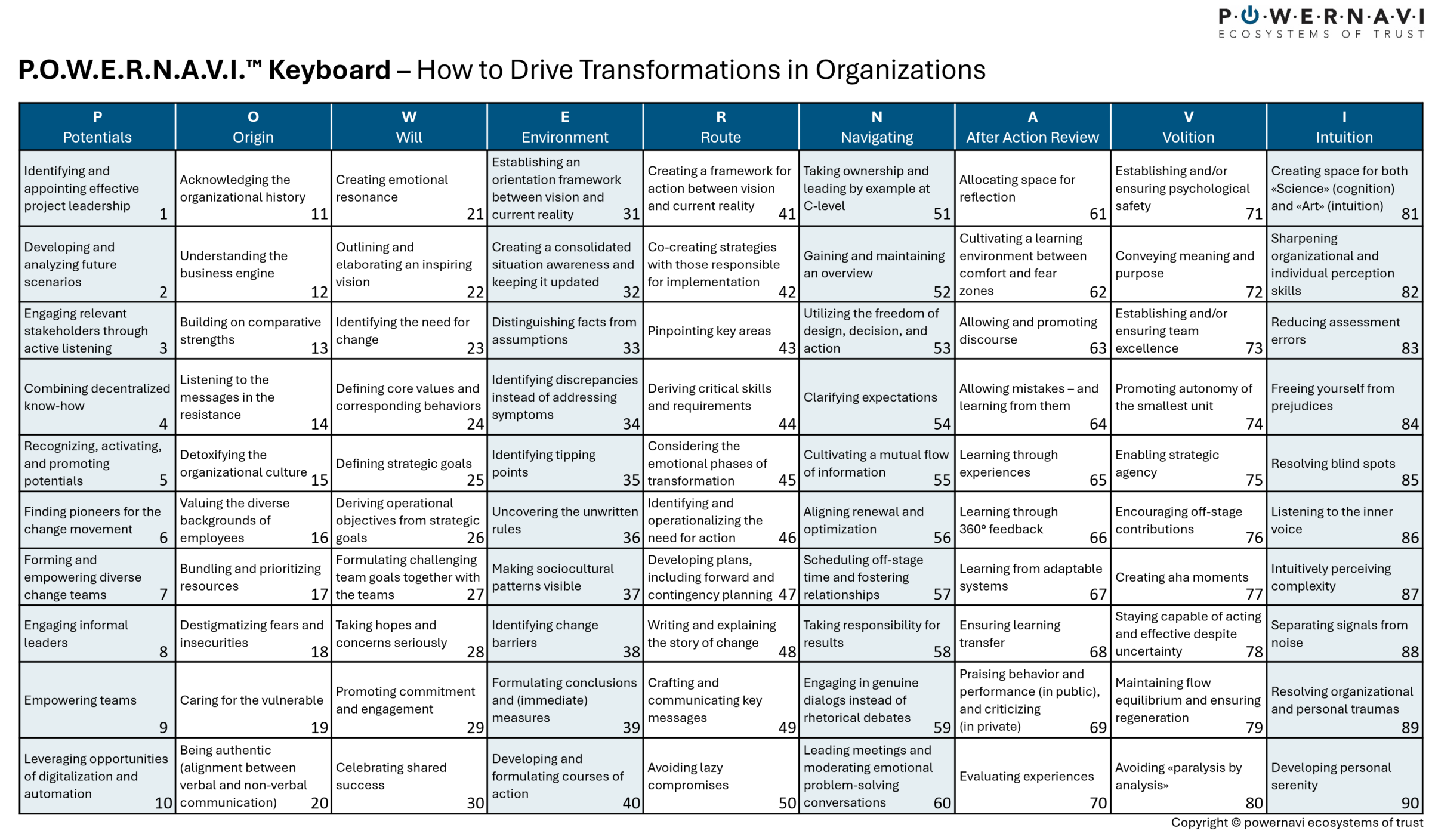Transformation
Let's co-create organizational systems that enable smarter and faster action!
Transformation Services
P.O.W.E.R.N.A.V.I.™ Keyboard
Customizing and implementing the P.O.W.E.R.N.A.V.I.™ Keyboard.
Change Cube
Scanning drivers and blockers of change (see Change Cube).
Transformative Storytelling
Crafting tailored narratives that help transform employees' fears into intrinsic motivation for change.
How to Drive Transformations in Organizations
Driving future-ready transformation in organizations requires a holistic approach that blends strategic thinking, trust-based leadership, and team excellence. For example: How do we successfully renew the system logic?
Let the 90 keys of the P.O.W.E.R.N.A.V.I.™ Keyboard inspire you to compose and play the music that fits your organization in its next development phase. Enjoy the sound of transformation!
In this context, we understand transformation as that part of organizational change in which the existing system logic (“Why”, “How”, “What”; see The Golden Circle, Simon Sinek) is in general fundamentally changed and replaced by a new one. When transformation takes place in this way, not only are individual elements changed, but the organizational system logic as a whole is questioned and transformed.
The “why” focuses on the purpose, i.e. the overarching vision, mission, and raison d'être of the organization. The “how” describes the values, strategy, and core competencies, i.e. the way in which the “why” is to be achieved. The “what” comprises the products and services, i.e. the concrete outputs or offerings of the organization.
Accordingly, the organizational system logic shapes how decisions are made, resources are allocated, relationships are formed, and problems are solved. It is deeply anchored in the identity and (sub-)cultures of an organization and is often stabilized through routines and narratives.
P.O.W.E.R.N.A.V.I.™ Keyboard: 90 Keys
Our experience in transforming organizations is captured in the P.O.W.E.R.N.A.V.I.™ Keyboard. It is a tool for genuine transformation that demonstrates how change succeeds by contributing to all relevant change dimensions (see Change Cube).
Potentials
- 1: Identifying and appointing effective project leadership
- 2: Developing and analyzing future scenarios
- 3: Engaging relevant stakeholders through active listening
- 4: Combining decentralized know-how
- 5: Recognizing, activating, and promoting potentials
- 6: Finding pioneers for the change movement
- 7: Forming and empowering diverse change teams
- 8: Engaging informal leaders
- 9: Empowering teams
- 10: Leveraging opportunities of digitalization and automation
Origin
- 11: Acknowledging the organizational history
- 12: Understanding the business engine
- 13: Building on comparative strengths
- 14: Listening to the messages in the resistance
- 15: Detoxifying the organizational culture
- 16: Valuing the diverse backgrounds of employees
- 17: Bundling and prioritizing resources
- 18: Destigmatizing fears and insecurities
- 19: Caring for the vulnerable
- 20: Being authentic (alignment between verbal and non-verbal communication)
Will
- 21: Creating emotional resonance
- 22: Outlining and elaborating an inspiring vision
- 23: Identifying the need for change
- 24: Defining core values and corresponding behaviors
- 25: Defining strategic goals
- 26: Deriving operational objectives from strategic goals
- 27: Formulating challenging team goals together with the teams
- 28: Taking hopes and concerns seriously
- 29: Promoting commitment and engagement
- 30: Celebrating shared success
Environment
- 31: Establishing an orientation framework between vision and current reality
- 32: Creating a consolidated situation awareness and keeping it updated
- 33: Distinguishing facts from assumptions
- 34: Identifying discrepancies instead of addressing symptoms
- 35: Identifying tipping points
- 36: Uncovering the unwritten rules
- 37: Making sociocultural patterns visible
- 38: Identifying change barriers
- 39: Formulating conclusions and (immediate) measures
- 40: Developing and formulating courses of action
Route
- 41: Creating a framework for action between vision and current reality
- 42: Co-creating strategies with those responsible for implementation
- 43: Pinpointing key areas
- 44: Deriving critical skills and requirements
- 45: Considering the emotional phases of transformation
- 46: Identifying and operationalizing the need for action
- 47: Developing plans, including forward and contingency planning
- 48: Writing and explaining the story of change
- 49: Crafting and communicating key messages
- 50: Avoiding lazy compromises
Navigating
- 51: Taking ownership and leading by example at C-level
- 52: Gaining and maintaining an overview
- 53: Utilizing the freedom of design, decision, and action
- 54: Clarifying expectations
- 55: Cultivating a mutual flow of information
- 56: Aligning renewal and optimization
- 57: Scheduling off-stage time and fostering relationships
- 58: Taking responsibility for results
- 59: Engaging in genuine dialogs instead of rhetorical debates
- 60: Leading meetings and moderating emotional problem-solving conversations
After Action Review
- 61: Allocating space for reflection
- 62: Cultivating a learning environment between comfort and fear zones
- 63: Allowing and promoting discourse
- 64: Allowing mistakes – and learning from them
- 65: Learning through experiences
- 66: Learning through 360° feedback
- 67: Learning from adaptable systems
- 68: Ensuring learning transfer
- 69: Praising behavior and performance (in public), and criticizing (in private)
- 70: Evaluating experiences
Volition
- 71: Establishing and/or ensuring psychological safety
- 72: Conveying meaning and purpose
- 73: Establishing and/or ensuring team excellence
- 74: Promoting autonomy of the smallest unit
- 75: Enabling strategic agency
- 76: Encouraging off-stage contributions
- 77: Creating aha moments
- 78: Staying capable of acting and effective despite uncertainty
- 79: Maintaining flow equilibrium and ensuring regeneration
- 80: Avoiding «paralysis by analysis»
Intuition
- 81: Creating space for both «Science» (cognition) and «Art» (intuition)
- 82: Sharpening organizational and individual perception skills
- 83: Reducing assessment errors
- 84: Freeing yourself from prejudices
- 85: Resolving blind spots
- 86: Listening to the inner voice
- 87: Intuitively perceiving complexity
- 88: Separating signals from noise
- 89: Resolving organizational and personal traumas
- 90: Developing personal serenity

